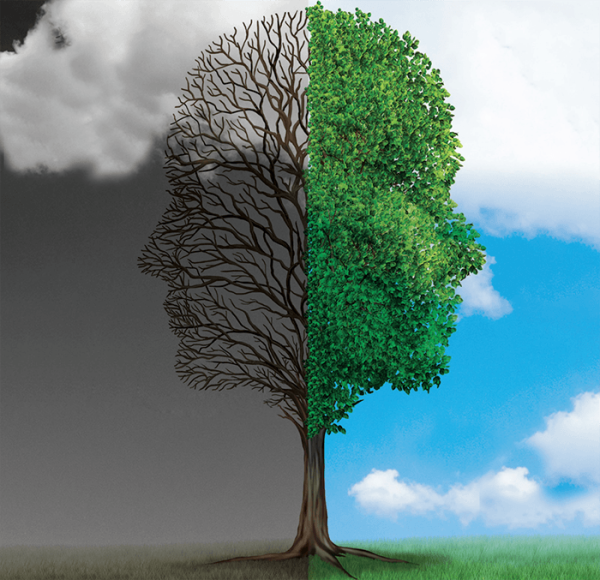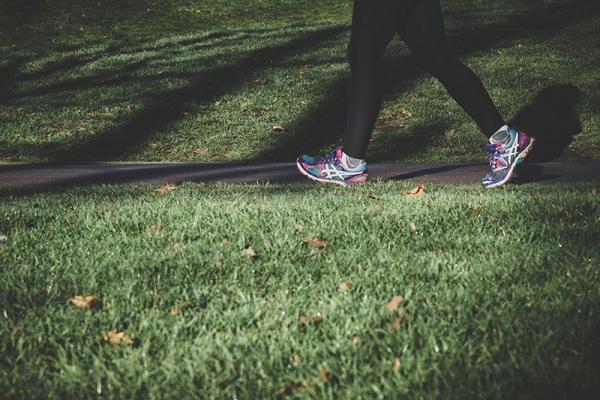Wearable Tech Tracks Ebbs and Flows of Bipolar Disorder
Research Suggests Sleep- and Activity-Based Approaches to Treatment

Wearable activity monitors allowed a research team led by IRP Distinguished Investigator Kathleen Merikangas to study how sleep and movement affect the moods of people with bipolar disorder and other mood disorders.
Mental Illness Awareness Week, observed this year from October 3 through 9, brings attention and support to the many patients and families who are coping with a variety of psychological conditions. Although an estimated 20 percent of U.S. adults and nearly 17 percent of youth have some type of mental health ailment, these conditions are still not well understood. However, research conducted at the National Institute of Mental Health (NIMH) is transforming our knowledge of one such mental health condition that affects more than two million Americans: bipolar disorder.
Bipolar disorder, formerly known as 'manic depression,' is characterized by episodes of intensely energetic and euphoric or irritable mood called ‘mania’ interspersed with periods of serious depression and lethargy. Nearly 90 percent of people with bipolar disorder are affected severely enough to interfere with work, school, and relationships. In addition, while about 2.3 million Americans have a diagnosis of bipolar disorder, it is likely many more people go undiagnosed.
IRP Distinguished Investigator Kathleen Merikangas, Ph.D., has spent her career conducting large population studies of mental health conditions like bipolar disorder and major depression. The findings from her decades of work indicate that bipolar disorder is characterized by more than just peoples’ moods.1,2
“When we studied adolescents in the general population, we learned that one of the most important characteristics of youth who begin to develop bipolar disorder is increased physical activity and energy rather than changes in mood,” Dr. Merikangas says.

The moods of people with bipolar disorder vacillate between depressive lows and euphoric highs.
In fact, physical activity has now been included as one of the core features in the diagnosis of bipolar disorder. People with the condition were not just shooting hoops or taking up jogging, however. They were fidgety and restless, moving around a lot even in situations where they would normally sit still.
“It’s often not a pleasant state,” Dr. Merikangas explains. “People describe feelings of agitation, which is often missed or mistaken for anxiety in clinical interviews.
Other researchers have shown that the same biological systems that are involved in regulating physical activity are also involved in maintaining a healthy balance in mood, sleep patterns, and energy levels. Based on this work and their own observations of patients with bipolar disorder, Dr. Merikangas and her research group set out to home in on the relationships between physical activity, sleep, and mood in patients with bipolar disorder in real-world settings. Between 2005 and 2013, they studied 242 adults with bipolar disorder, major depression, or no history of mood disorders. The participants in the study wore monitors on their wrists that collected constant, real-time measurements of their activity and sleep duration for two weeks. In addition, they were given electronic devices programmed with a survey that asked them several times per day to rate their mood and energy level on a scale from one to seven.
Dr. Merikangas’ team found that participants reported better moods on the survey when they had been more active earlier in the day. In addition, a lack of sleep was related to reduced energy and activity, whereas changes in mood had no impact on energy levels. Importantly, among participants with bipolar disorder, the influence of sleep and activity on their moods was much stronger than in those with depression or no mood disorder, and the sleep- and movement-induced boosts in mood and energy level that they experienced took longer to return to more typical levels.

Interventions that spur people with bipolar disorder to be more physically active could help them regulate their moods.
“These unidirectional links suggest that increasing physical activity may be a way that we could intervene in bipolar disorder,” Dr. Merikangas says. “In fact, one of the most consistent findings in our studies and others across the world is that people with bipolar disorder tend to spend more time with lower levels of physical activity and lower energy levels than people without the condition. This may explain why physical activity interventions are beginning to show promise in the treatment of bipolar disorder.”
Since those studies were published, Dr. Merikangas’ team has expanded its work to more than 2,000 adults and youth living in multiple locations. In addition, Dr. Merikangas and several experts from outside NIH are developing a program called “Rhythms and Blues” in the NIH Clinical Center in collaboration with IRP senior investigator Kong Chen, Ph.D. The program is expanding the mobile assessments Dr. Merikangas previously used in order to study how fluctuations over time in multiple physiologic systems, including heart rate, body temperature, and sleep patterns, affect symptoms of mood over longer periods of time, including in different seasons.
Dr. Merikangas and her collaborators are particularly interested in learning about how environmental factors such as light influence systems involved in bipolar disorder because people with the condition tend to have greater sensitivity to anything that can disrupt their biologic rhythms.3 In collaboration with IRP senior investigator Samer Hattar, Ph.D., the group is applying information from basic science to gain insight into the brain pathways involved in the effects of light on mood, cognition, sleep, and physical activity.4 Measures of sensory systems such as smell and taste are also being included in their studies through a collaboration with IRP Lasker Clinical Research Scholar Paule Joseph, Ph.D., C.R.N.P.

Dr. Kathleen Merikangas
All this work is being carried out in collaboration with an international consortium established by IRP researchers called the Motor Activity Research Consortium for Health (mMARCH), which is conducting research at 22 locations around the world. Dr. Merikangas and her colleagues hope the resulting large-scale studies will allow them to generalize their findings and extend their work to other conditions beyond bipolar disorder. They are also piloting new devices and apps to collect data from patients, as well as using their findings to develop an analytical toolkit to help evaluate bipolar disorder and other mental health conditions.
“Studying people in their daily life settings over time to characterize individual dynamics of these systems is important for gaining insight into targets for treatment in people with bipolar disorder and other conditions, such as migraine,” Dr. Merikangas says, “and it is likely to inform our understanding of these systems in the general population as well.”
Subscribe to our weekly newsletter to stay up-to-date on the latest breakthroughs in the NIH Intramural Research Program.
References:
[1] Dysregulation of Objectively Assessed 24-Hour Motor Activity Patterns as a Potential Marker for Bipolar I Disorder: Results of a Community-Based Family Study. Shou H, Cui L, Hickie I, Lameira D, Lamers F, Zhang J, Crainicenanu C, Zipunnikov V, Merikangas KR. Transl Psychiatry. 2017 Aug 22;7; e1211. doi.org/10.1038/tp.2017.136
[2] Real-Time Mobile Monitoring of the Dynamic Associations Among Motor Activity, Energy, Mood, and Sleep in Adults with Bipolar Disorder. Merikangas KR, J, Hickie IB, Cui L, Shou H, Merikangas AK, Zhang J, Lamers F, Crainiceanu C, Volkow ND, Zipunnikov V. JAMA Psychiatry. 2019 Feb;76(2):190-198. doi: 10.1001/jamapsychiatry.
[3] Dunster GP, Swendsen J, Merikangas KR. Real-time mobile monitoring of bipolar disorder: a review of evidence and future directions. Neuropsychopharmacology. 2021 Jan;46(1):197-208. doi: 10.1038/s41386-020-00830-5.
[4] Paksarian D, Rudolph KE, Stapp EK, Dunster GP, He J, Mennitt D, Hattar S, Casey JA, James P, Merikangas KR. Association of Outdoor Artificial Light at Night With Mental Disorders and Sleep Patterns Among US Adolescents. JAMA Psychiatry. 2020 Dec 1;77(12):1266-1275. doi: 10.1001/jamapsychiatry.2020.1935.
Related Blog Posts
This page was last updated on Wednesday, May 24, 2023
